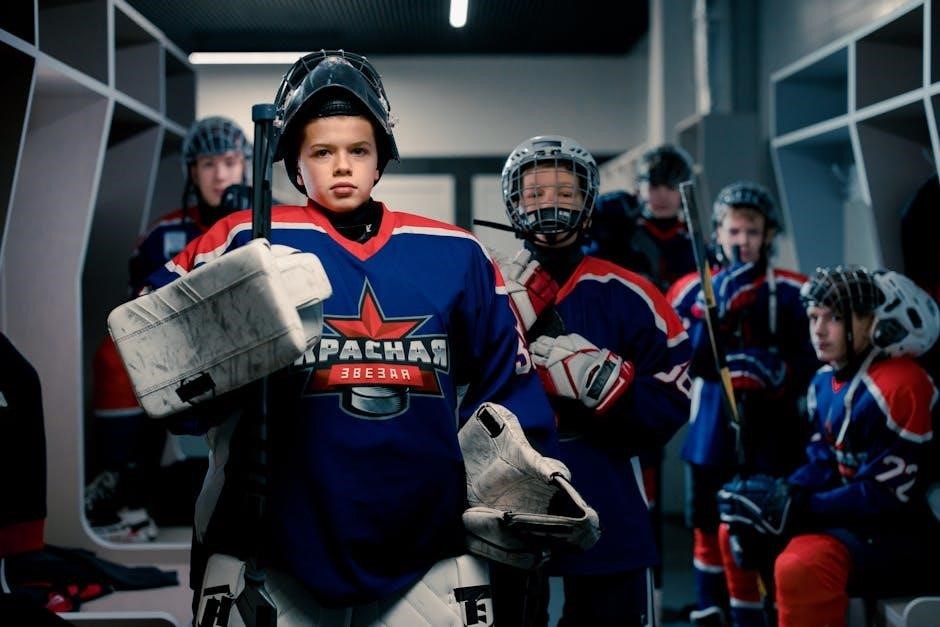
Properly fitting goalie gloves are essential for performance, grip, and protection. This guide helps you understand sizing, measurement techniques, and factors influencing your perfect fit.
Why Proper Fit Matters
A proper fit in goalie gloves is crucial for both performance and comfort. Gloves that are too tight can restrict movement and cause discomfort, while gloves that are too loose may compromise grip and control. A well-fitting glove ensures optimal grip on the ball, better protection for the hands, and improved dexterity. Ill-fitting gloves can lead to reduced performance, increased risk of injury, and premature wear of the latex palm. Goalies rely on their gloves as an extension of their hands, so it’s essential to prioritize a fit that balances snugness and flexibility. Proper fit enhances confidence, allowing goalies to focus on their game without distractions.
Overview of the Guide
This comprehensive guide provides detailed insights into selecting the perfect goalie gloves. It covers essential aspects such as hand measurement techniques, understanding sizing charts, and factors influencing fit. The guide also explores brand-specific sizing variations, materials, and care tips to extend glove durability. Whether you’re a seasoned player or a beginner, this resource offers practical advice to ensure a optimal fit. By following the outlined steps, goalies can make informed decisions, enhancing their performance and comfort during games. The guide is structured to address common sizing mistakes and offers solutions for achieving the best possible fit tailored to individual preferences and playing styles.
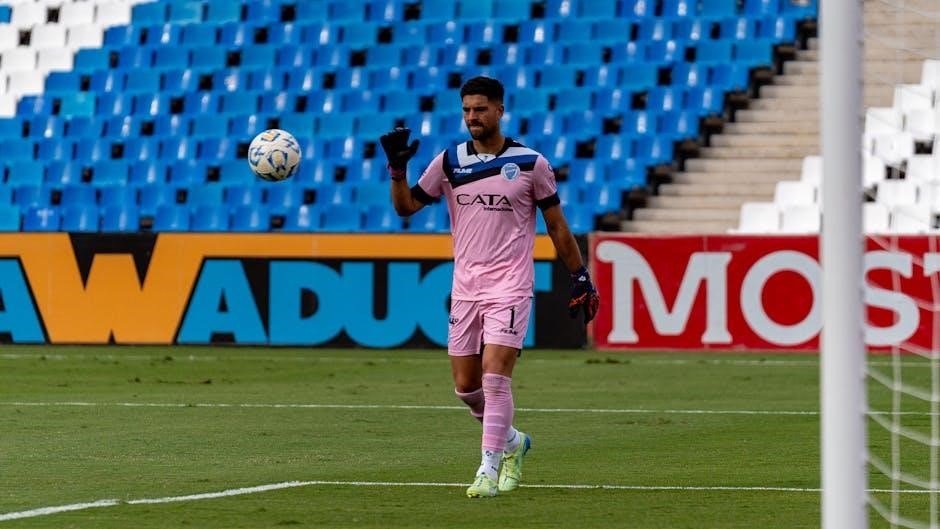
Understanding Hand Measurement
Measuring your hand accurately is crucial for selecting the right goalie gloves. Focus on hand circumference and finger length to ensure proper fit and optimal performance.
How to Measure Hand Circumference
To measure your hand circumference, use a flexible tape measure. Wrap it around the widest part of your palm, just below the base of your fingers. Ensure the tape is snug but not tight, keeping your hand flat and fingers together. Note the measurement in inches or centimeters. This step is crucial for determining your glove size accurately. Proper fit ensures better grip, control, and comfort. For precise results, avoid wrapping the tape too loosely or tightly. If you don’t have a tape measure, you can trace your hand on paper and measure the circumference. This method helps in selecting gloves that match your hand size perfectly.
Measuring Finger Length
Measuring finger length is crucial for ensuring a snug and comfortable fit in goalie gloves. To measure accurately, place your hand flat with fingers together. Using a ruler or tape measure, measure from the base of your palm to the tip of your longest finger. This helps determine the length of the glove fingers. Proper finger length ensures optimal grip and dexterity. If your fingers are too long or too short for the glove, it may affect performance. For best results, measure both hands and use the larger measurement. This step ensures your gloves fit naturally, providing better control and movement during play.
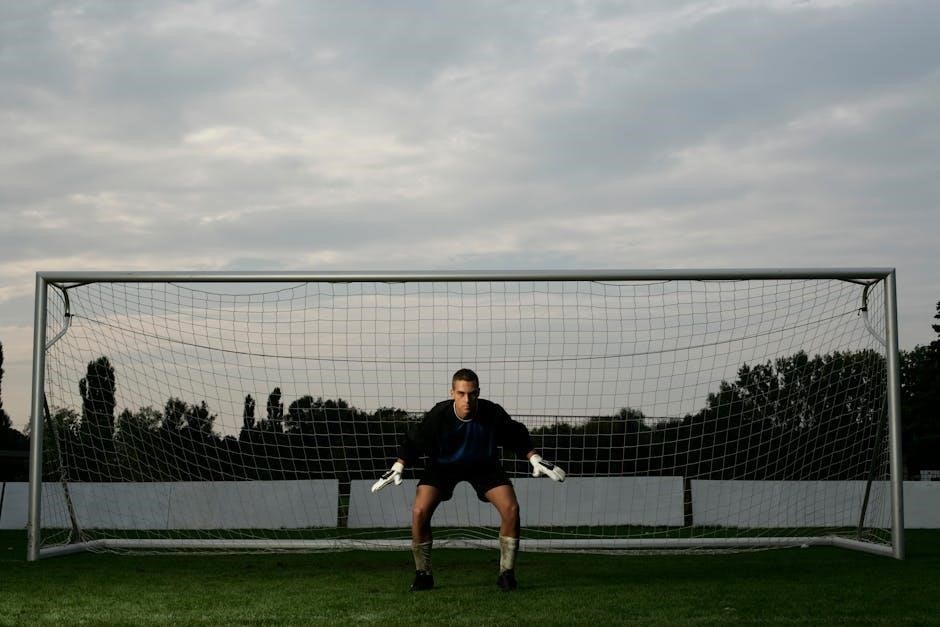
General Sizing Chart
The chart provides standard glove sizes based on palm circumference and finger length, helping you choose the best fit for optimal performance and comfort.
Age Groups and Corresponding Sizes
Goalie gloves are typically categorized by age groups to ensure proper fit. Youth sizes range from 6 to 8, suitable for younger players, while junior sizes (7-9) cater to teenagers. Adult sizes (8-12) are designed for mature hands. Each size corresponds to specific palm and finger measurements, ensuring optimal grip and comfort. For example, a size 8 glove is ideal for smaller adult hands, while size 12 suits larger hands. Some brands offer half sizes for a more precise fit. Proper sizing by age ensures better performance and protection, though individual hand size may vary. Always measure your hand to confirm the best fit for your needs.
Size Chart for Adults vs. Youth
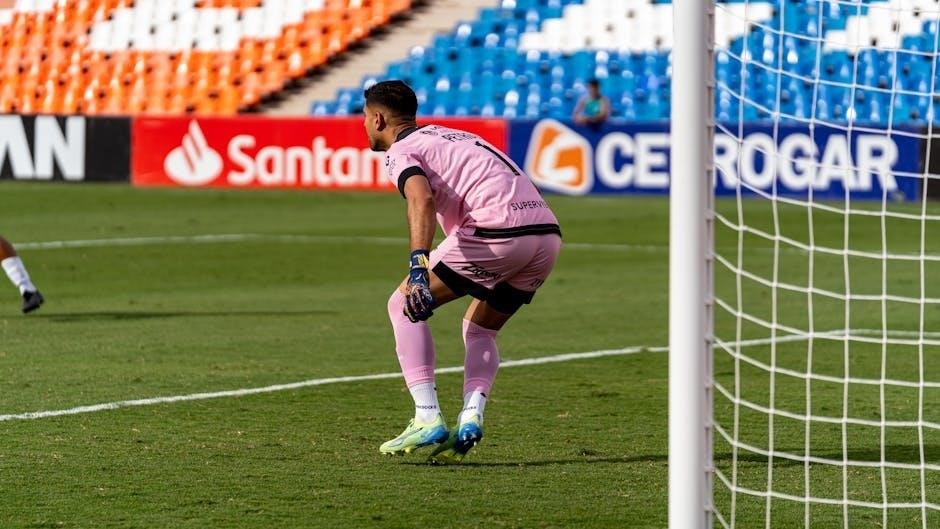
Adult and youth goalie gloves differ significantly in size to accommodate varying hand sizes. Adult gloves range from size 8 to 12, with size 8 suitable for smaller hands and size 12 for larger ones. Youth sizes typically range from 6 to 8, designed for younger players with smaller palms and fingers. Each size corresponds to specific measurements, ensuring a snug yet comfortable fit. For example, a size 8 adult glove measures around 8 inches in palm circumference, while a youth size 6 measures approximately 6.5 inches. Proper sizing ensures optimal grip, control, and protection. Always measure your hand to choose the correct size for your needs, as sizes can vary slightly between brands.
Factors Influencing Glove Size
Palm size, finger length, and personal fit preferences significantly impact goalie glove sizing. Proper measurement ensures optimal performance and comfort.
Palm Size vs. Overall Hand Size
Palm size and overall hand size are crucial when determining goalie glove fit. The palm, including the thumb, should fit snugly without compressing or restricting movement. A properly sized palm ensures better grip and control of the ball. Some gloves prioritize palm size over finger length, while others balance both. Measure your hand’s circumference just below the knuckles, excluding the thumb, to find your ideal size. A well-fitting palm allows optimal latex contact, enhancing performance. Consider your grip style—some goalkeepers prefer a tighter fit for precision, while others opt for a looser feel. Proper palm sizing is key to both comfort and effectiveness.
Fit Preferences: Snug vs. Loose
Goalkeepers often debate whether a snug or loose fit is better for performance. A snug fit provides precise control and better grip, especially for players prioritizing dexterity. However, it may restrict movement for those with larger hands. A loose fit offers comfort and flexibility, ideal for goalkeepers who prefer ease of motion. Personal preference plays a significant role, but proper support and grip are essential. Some gloves cater to specific styles, so trying them on is recommended. Balancing snugness and comfort ensures optimal performance without compromising protection or mobility. Ultimately, the choice depends on individual playing style and comfort priorities.
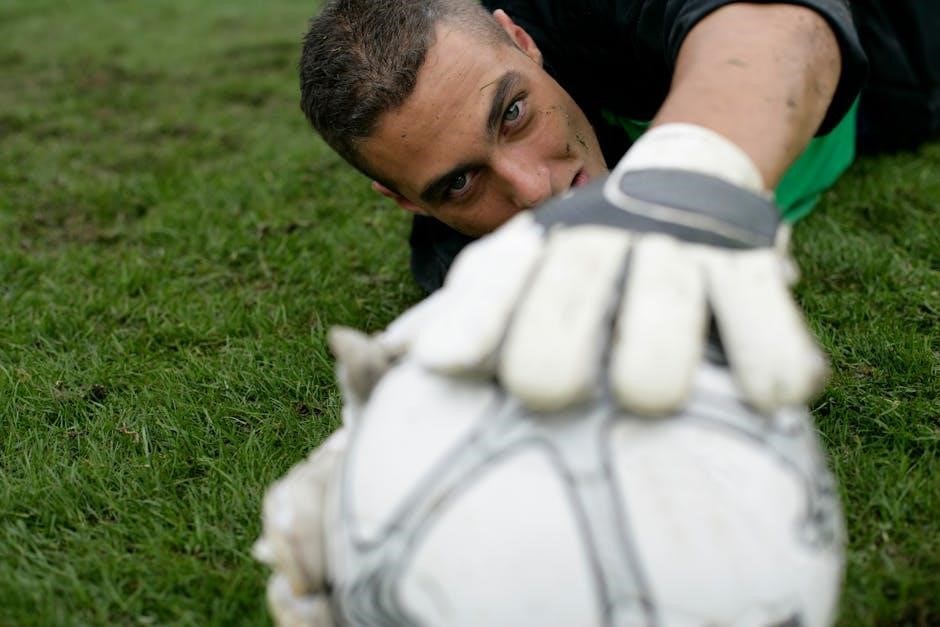
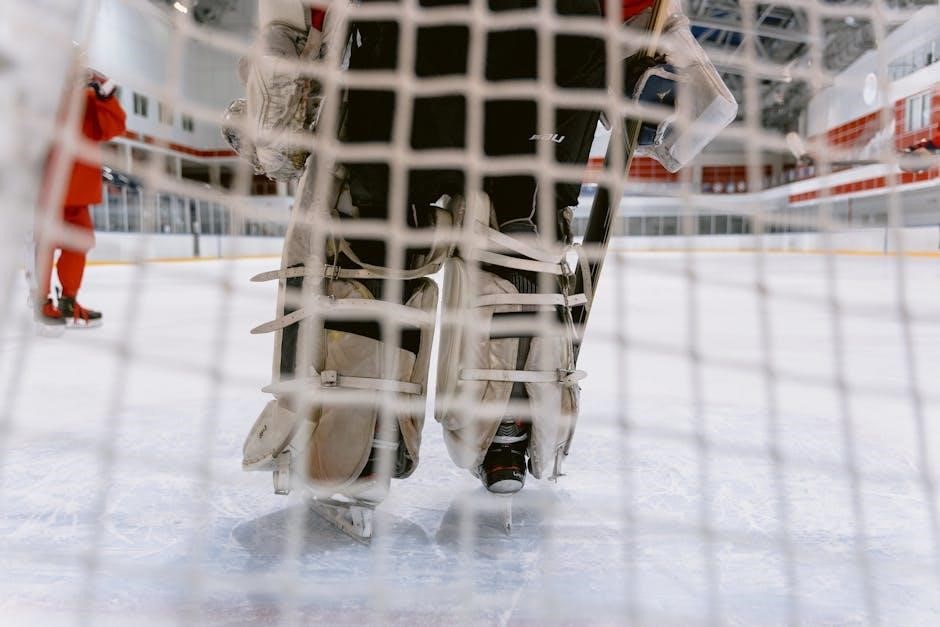
Choosing the Right Size
Selecting the right goalie glove size ensures optimal performance, grip, and comfort. Measure hand circumference and finger length, then compare with size charts for the best fit.
Importance of Fit for Performance
A well-fitting goalie glove is crucial for peak performance. Proper fit ensures maximum grip, control, and dexterity, allowing goalies to handle the ball effectively. Ill-fitting gloves can lead to reduced performance, discomfort, and even injuries. A snug fit provides better feel and responsiveness, while a glove that’s too loose may compromise grip and precision. Correct sizing also ensures optimal protection for the hands, especially during high-impact saves. Measuring hand circumference and finger length accurately helps determine the ideal size. By prioritizing fit, goalies can enhance their ability to perform at their best during games and training sessions.
Using a Printable Sizing Tool
A printable sizing tool is a reliable method to determine your goalie glove size accurately. By printing the tool and measuring your hand against it, you can ensure a precise fit. This method is especially useful for those who prefer a visual guide or are unsure about manual measurements. Simply print the chart, place your hand on it, and compare your measurements to the size guide. This approach minimizes errors and helps you select the correct size without guessing. Many brands offer downloadable sizing tools, making it easy to find one that matches your needs. Using this tool ensures your gloves fit comfortably and perform optimally during games.
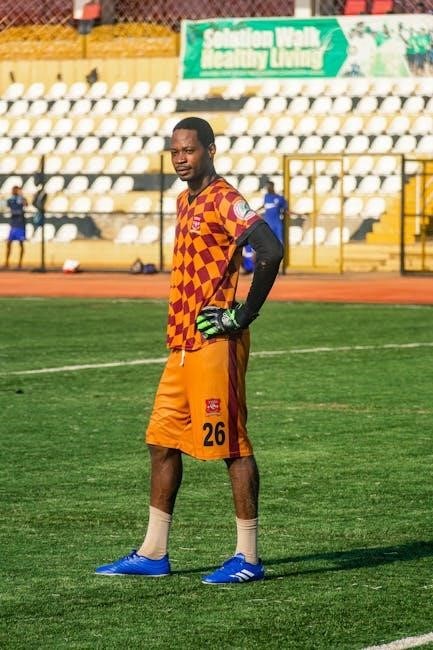
Brand-Specific Sizing
Each brand offers unique sizing standards, so it’s crucial to consult their specific charts when selecting gloves. Brands like Nike, Adidas, and Uhlsport may vary in fit and sizing.
Popular Brands and Their Fits
Popular brands like Nike, Adidas, and Uhlsport offer distinct fits. Nike gloves often feature a snug, responsive design, while Adidas tends to provide a slightly roomier fit. Uhlsport is known for its precise, anatomical shape, catering to goalies who prefer a tight grip. Sondico gloves are budget-friendly with a comfortable fit. Each brand tailors its sizing to specific preferences, so consulting their size charts is essential. Some brands may run larger or smaller than others, emphasizing the importance of trying gloves on before purchasing. Understanding these nuances helps goalies select the perfect fit for their hand shape and playing style, ensuring optimal performance and comfort during games.
How Brand Sizing May Differ
Brand sizing for goalie gloves can vary significantly, even within the same numerical size. For instance, Uhlsport gloves may run slightly smaller, offering a tighter fit, while Adidas tends to be more generous in their sizing. Nike often provides a snug, responsive fit, whereas Reusch may cater to goalies with broader hands. Some brands use European sizing, which differs from US standards, adding to potential confusion. It’s crucial to consult each brand’s specific size chart and read reviews to understand how their gloves fit. Trying them on, if possible, ensures the best match. These variations highlight the importance of researching before purchasing to avoid sizing mismatches and ensure optimal performance.
Glove Materials and Thickness
Goalie gloves feature various materials like latex, synthetic, and hybrid blends, offering different grip and durability levels. Thickness varies, with thicker palms for elite play and thinner for precision.
Types of Latex and Grip
Goalie gloves feature various types of latex and grip technologies to enhance performance. Natural latex provides superior grip and durability, while synthetic latex offers a cost-effective alternative. Some gloves combine both materials for a balanced feel. Advanced grip technologies include textured palm surfaces and additives that improve tackiness, even in wet conditions. The thickness of the latex varies, with thicker options offering more padding and protection, while thinner latex allows for better ball control. Proper maintenance, such as occasionally dampening the palms, can extend the life of the latex and maintain its grip. The choice of latex type depends on personal preference, playing style, and the level of competition.
Thickness Options for Different Play Styles
Goalie gloves come in varying thickness levels to cater to different play styles and preferences. Thinner gloves (3mm) provide exceptional ball control and dexterity, ideal for goalies who prioritize close-range handling. Medium thickness (4mm) offers a balanced mix of grip, durability, and protection, suitable for most players. Thicker gloves (5mm) are designed for goalies who need maximum cushioning and impact absorption, often preferred in high-intensity or physical games. The choice of thickness depends on personal preference, playing style, and the level of competition. Proper maintenance, such as keeping the latex damp, enhances performance regardless of thickness. Selecting the right thickness ensures optimal comfort and effectiveness in goalkeeping.
Care and Maintenance
Regular cleaning and moisturizing extend glove durability. Dampen palms with water for optimal grip. Proper storage prevents deformation, ensuring long-lasting performance and maintaining latex quality.
Cleaning and Moisturizing Gloves
Cleaning and moisturizing your goalie gloves are crucial for maintaining their performance and longevity. Start by gently wiping the palms with a damp cloth to remove dirt and sweat. For deeper cleaning, mix mild soap with warm water, dip a soft brush, and scrub the latex palm. Avoid harsh chemicals or abrasive materials that can damage the latex. After cleaning, allow the gloves to air dry naturally. To maintain grip and softness, apply a latex moisturizer or glove conditioner. Regular moisturizing prevents the latex from drying out and cracking. Proper care ensures optimal grip, durability, and comfort, keeping your gloves in top condition for every game.
Extending Glove Durability
To extend the life of your goalie gloves, proper care is essential. After use, gently wipe the palms with a damp cloth to remove dirt and sweat. Avoid machine washing, as it can damage the latex. Instead, hand wash with mild soap and lukewarm water, using a soft brush to scrub the palm. Allow the gloves to air dry naturally, away from direct sunlight and heat. Store them in a cool, dry place to prevent moisture buildup. Regularly applying a latex moisturizer or conditioner helps maintain the palm’s grip and softness. Avoid using harsh chemicals or abrasive materials, as they can degrade the latex. By following these steps, you can ensure your gloves remain durable, comfortable, and perform at their best for a longer period.
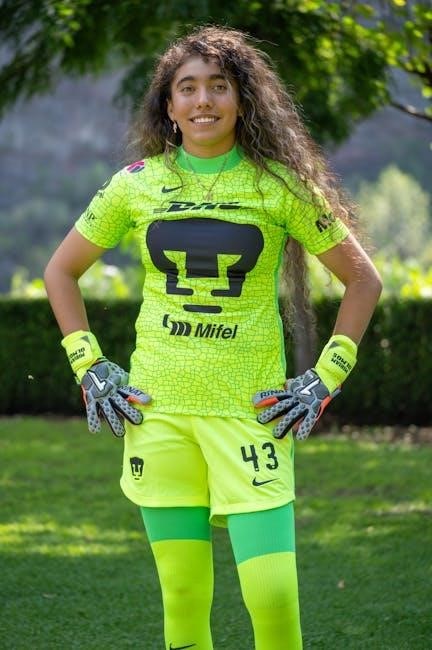
Common Sizing Mistakes
Common sizing mistakes include guessing sizes instead of measuring and ignoring brand-specific fits. These errors can lead to poor performance and discomfort.
Mistakes to Avoid When Sizing
One common mistake is guessing glove sizes instead of measuring hand circumference and finger length accurately. Another error is not considering brand-specific fits, as sizing can vary significantly between brands. Additionally, some goalies assume their glove size matches their everyday shoe or clothing size, which is unrelated. Ignoring the importance of palm size versus overall hand size can also lead to poor fit. Trying gloves on before purchasing, especially for first-time buyers, is highly recommended. Relying solely on online size charts without comparing to brand-specific guides can result in discomfort and reduced performance. Always measure carefully and consult brand sizing charts to ensure the best fit.
How to Ensure the Best Fit
To ensure the best fit for goalie gloves, start by accurately measuring your hand circumference and finger length using a flexible tape measure. Compare these measurements to the size chart provided by the brand. Trying gloves on before purchasing is ideal, as fit can vary between brands. If shopping online, use a printable sizing tool to gauge your size more precisely. Consider your personal preference for snugness or a bit of room, as this affects performance. Pay attention to palm size and overall hand proportions, as these can impact grip and comfort. Finally, consult customer reviews or brand guides for additional insights to make an informed decision.

Specialized Gloves
Specialized gloves cater to unique positional demands and personal preferences. Custom options offer tailored fits and enhanced performance for goalies seeking optimal comfort and grip.
Gloves for Different Positions
Goalie gloves are designed to meet the specific demands of different positions. For goalkeepers, gloves prioritize grip, protection, and flexibility. Brands like Adidas offer snug fits for precision, while Nike provides medium to loose fits for comfort. Uhlsport gloves are known for their loose fit, catering to goalies needing more hand movement. Field players may opt for thinner palms for better control. The choice often depends on the position’s requirements, with goalies favoring thicker palms for durability and grip. Each brand tailors its fit to suit various playing styles, ensuring optimal performance for both goalkeepers and field players. Proper sizing ensures enhanced comfort and effectiveness during the game.
Custom and Specialty Gloves
Custom and specialty gloves offer tailored solutions for specific needs. Goalies can opt for personalized fits, materials, and features. Some brands provide bespoke options, allowing players to choose latex type, thickness, and even design. Specialty gloves cater to unique preferences, such as eco-friendly materials or enhanced grip. Customization ensures a perfect fit and optimal performance. Players with specific hand shapes or preferences benefit from these options. Specialty gloves may also include features like reinforced padding or adjustable closures. This personalized approach enhances comfort and functionality, making them ideal for professionals or those with particular requirements. Custom orders typically require precise measurements for the best results.
Selecting the right goalie gloves involves understanding sizing, fit, and personal preferences. Proper measurement and consideration of material quality ensure optimal performance and durability, enhancing your game experience.
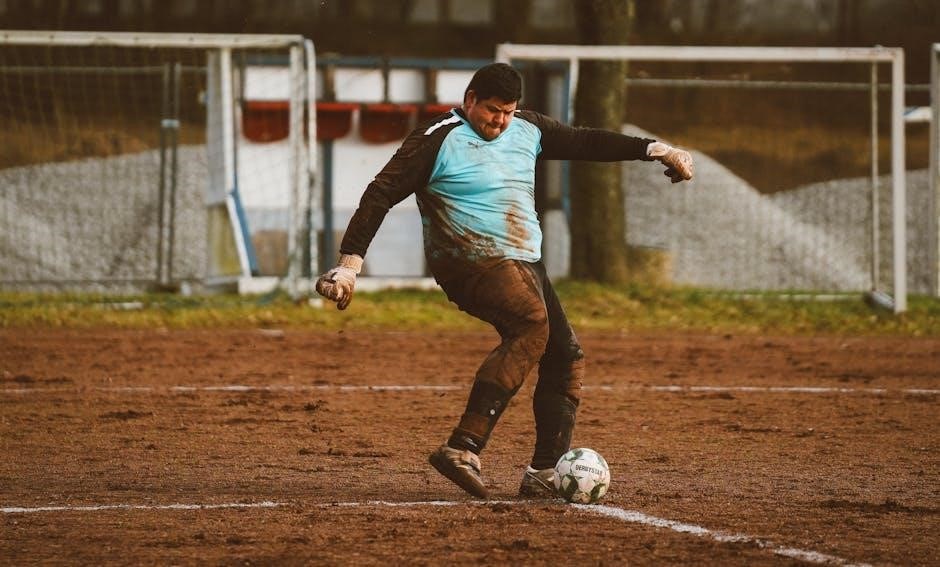
Final Tips for Choosing Gloves
When selecting goalie gloves, prioritize proper fit and material quality. Consider your playing style and position to ensure optimal performance. Refer to sizing charts and measure accurately. Try gloves on if possible, and maintain them with water and moisturizer for durability. Avoid sizing mistakes by not guessing your size. Custom options may offer better fit. Ultimately, the right gloves enhance grip, protection, and confidence in the game. Always opt for reputable brands and follow care instructions to extend glove life. Your gloves are key to your performance, so choose wisely.
Encouragement to Try Before Buying
Trying goalie gloves before purchasing is highly recommended to ensure the best fit and comfort. Visit a local sports store to test different sizes and brands, as sizing can vary. This step helps avoid returns and ensures the gloves meet your performance needs. Proper fit directly impacts grip, protection, and confidence. Don’t hesitate to ask for assistance from store staff to find your ideal pair. If buying online, use sizing charts and reviews to guide your decision. Remember, well-fitting gloves enhance your game, so take the time to get it right. Your performance deserves the perfect fit.